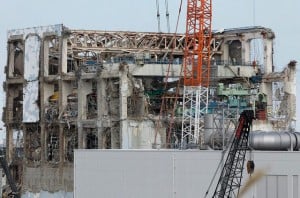The disaster that engulfed Japan continues a year later as fears that the former nuclear power plant, now radioactive-pile, Fukushima-Daichi could produce additional plumes of material that spread radiation throughout the northern hemisphere “altering civilization as we know it”.
Oregon Senator Ron Wyden visited the hot zone last month wearing a protective suit and assessed the situation on April 17 by saying “… things were worse than reported”. [read]
Interviewed days later on MSNBC [top of page] about his concerns and what he saw on the ground, Senator Wyden responded:
“They obviously have a long, long way to go. When you go in there you see hundreds of tons of debris; you have huge trucks, storage tankers thrown about like they were my four-year-old twin’s toys. It’s very clear that there are substantial health questions that have to be addressed now.”
“I’m particularly concerned about Unit 4, there are these six reactors. If for example you had an earthquake or tsunami hit those particular pools, those pools could rupture. That could mean that the fuel rods catch fire and melt down. You’d have radiation in the air that would be a huge challenge to control.”
“[Tokyo Electric Power Company] TEPCO has a 10-year plan for moving the spent fuel rods to dry-casks, to dry storage. That in my view must be sped up because if another earthquake or tsunami hits, it could be very damaging, with possibly more radiation than earlier.” [TEPCO release here]
Responding to a question about Japanese food safety, he didn’t want to make “scientific judgments”, saying,

“I will tell you when I was visiting, and we were getting on the bus to go to the airport, people said to Oh, Pretty amazing Ron that you didn’t have an earthquake or a tremor while you were there. This is not an abstract question. This happens very frequently there.”
Senator Wyden would not speculate on the issue of radiation hitting the west coast of the US, but he did say that “… certainly these reactors are very close to the ocean. In my home state, we’ve long been concerned about tsunamis and earthquakes.”
“I think its time to get this right. We need to focus on what kind of design there ought to be for nuclear plants, where they ought to be located; certainly the question of putting them right next to oceans ought to be problematic to anyone. Those are the kind of issues that can’t be ducked any longer.”
Senator Wyden sits on the US Senate Energy Committee, and so has received numerous mailings from Cold Fusion Now about the importance of funding cold fusion, or low-energy nuclear reactions LENR. LENR is a type of fusion-power based on a fuel of hydrogen from water, with no radioactive materials used at all.
Still the Senator speaks to the rear-view mirror.
Energy from LENR can be produced from just a few grams each of hydrogen and nickel, a common metal used industrially throughout the world. The science has been developing over two decades, yet only in the last year is a technology emerging. Lack of funding has hampered advancement due to legislators and agencies that mistakenly believe that “there is no such thing” as cold fusion.
However, several independent new energy companies beg to differ as they develop commercial products that bring next-generation nuclear energy to market. The first demonstrated prototypes are small and portable and will not need to be connected to an electrical grid. These technologies will be able to operate anywhere, be it coastal or inland.
There is virtually no chance of a meltdown with cold fusion generators based on a reaction described as a nickel-hydrogen exothermic reaction. The hydrogen-infused nickel metal powder that hosts the reaction will melt at 1453 C, thereby stopping the reaction. There’s no radiation danger from melted nickel.
Though initially in the form of steam generators and hot-water boilers, adding micro-turbines can turn that thermal energy to off-grid electricity. Using a fuel of hydrogen, access to water means access to fuel for a safe and clean energy source.
Akio Matsumura has reported devastating news about the reactor 4, saying that it could release radiation 10x what the Chernobyl explosion did. If all the radioactive fuel at the Daichi site were to melt-down, it could release 85x what Chernobyl did. [read]
Here, Mr. Matsumura gives some details about the possible dangers and calls for an “independent assessment team, independent of TEPCO, to see what will be the best way to improve the situation …. which is critical now …”
Conventional nuclear power provided 30% of the electricity for Japan, and the plan was to increase that share to 50% by the year 2050. Now, the decision has been implemented to dramatically reduce Japan’s dependence on this form of nuclear power which uses a highly radioactive and dangerous fuel, and embark on an all-out program of alternatives. It’s a hasty move, but seemingly inevitable.
Humans pretend to plan for the worst, but never imagine it really happening. Rising sea levels can cause greater storm surge making coastal nuclear power plants even more vulnerable.
Let’s remind Mr. Wyden, and all the Energy committee members that mitigation begins with funding LENR.
Senator Ron Wyden Home
Letters to Senate request hearings on DoE and USPTO by Ruby Carat November 10, 2011 contains the addresses of all Senate Energy sub-committee members.
